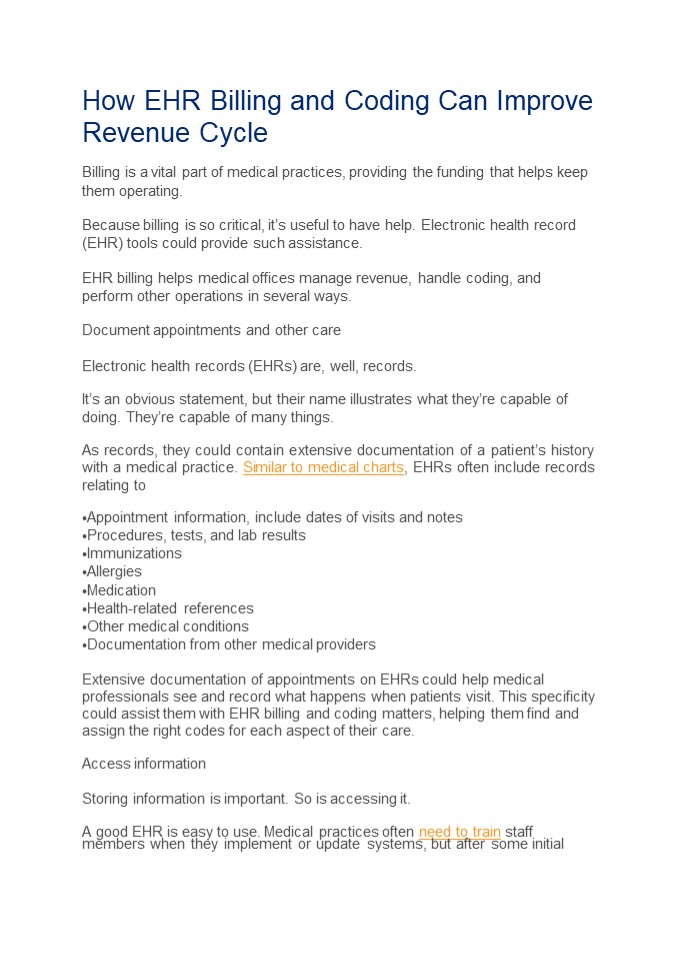How EHR Billing and Coding Can Improve Revenue Cycle PowerPoint PPT Presentation
Title: How EHR Billing and Coding Can Improve Revenue Cycle
1
- How EHR Billing and Coding Can Improve Revenue
Cycle - Billing is a vital part of medical practices,
providing the funding that helps keep them
operating. - Because billing is so critical, its useful to
have help. Electronic health record (EHR) tools
could provide such assistance. - EHR billing helps medical offices manage revenue,
handle coding, and perform other operations in
several ways. - Document appointments and other care
- Electronic health records (EHRs) are, well,
records. - Its an obvious statement, but their name
illustrates what theyre capable of doing.
Theyre capable of many things. - As records, they could contain extensive
documentation of a patients history with a
medical practice. Similar to medical charts, EHRs
often include records relating to - Appointment information, include dates of visits
and notes - Procedures, tests, and lab results
- Immunizations
- Allergies
members when they implement or update systems,
but after some initial
2
- orientation, the best medical billing and EHR
software is mostly or wholly intuitive. - Intuitive functions allow people to easily use
software systems and extract and apply
information from them. They also make it easy to
add and store information for future use. - Billing, filing and tracking claims, and
collecting revenue are just a few of the tasks
that efficient and productive EHR solutions could
enable. - Share information with patients
- Medical professionals arent the only people
interested in using EHRs. - Patients want their health information. With
growing numbers of electronic devices and
internet use, patients are able to retrieve and
use it themselves. - Sharing information could start during their
appointments. To facilitate this sharing, the
authors of one study suggested that medical
practitioners - Review background information in the EHRs before
they see their patients. - Greet and interact with patients to strengthen
personal interactions. - Allow patients to see aspects of their records,
such as lab - results or x-rays.
- Enlist patients to participate in the charting
process.
management systems to transmit it.
3
- Of course, since its so easy to share
information, its also easy to hack it. When
using protected health information, medical
providers are required to protect patient
privacy. To protect it, they could follow Health
Insurance Portability and Accountability Act of
1996 (HIPAA) guidelines. - Some HIPAA guidelines include
- Sending the minimum amount of information needed.
- Encrypting health information, which is changing
readable text into text that consists of random
letters and numbers that requires taking special
measures to decipher. - Creating data safeguards such as using pass
codes. - Taking such measures could help transmit
information not only safely, but more
efficiently. - Track and manage the claims process
- When compiling, sending, checking, and resending
insurance claims, keeping track of the process is
vital. - Since it contains all parts of a patients health
record with a practice, an EHR could help medical
practitioners track whats happening with a
persons claim. - As the claim moves through the billing process,
office workers could make notes about whats
happening. - If theres a deadline for taking certain actions,
an EHR could inform employees.
professionals. Instead of sorting through page
after page in a paper file,
4
employees could use search functions to find
insurance claim documentation and evidence that
could support such claims. EHRs also contain all
of a patients information in one digital place,
so offices can share it and are also less likely
to lose it.

